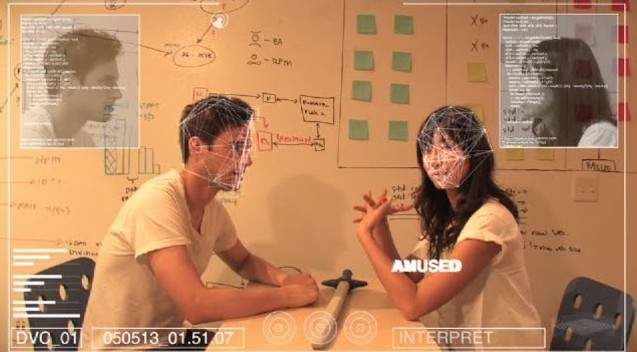We might be seeing some inspiration from Leo Gabriadze’s Unfriended, and definitely something of Steven Spielberg’s Minority Report, Mark Netter’s Nightmare Code is a science-fiction thriller about a computer that modifies human behavior. It’s a stylish mix of science-fiction and horror that culminates in a conclusion that nobody sees coming. Find out more about the movie from our interview with Netter.
Nightmare Code is one of the true success stories of crowdfunding. What’s your secret?
We went to Indiegogo for post-production finishing funds, so we already had an edited film, shot a year and a half earlier, but there’s over 600 individual VFX that ended up being created by Psychic Bunny here in LA.
We had enough footage to cut together for a trailer and an “ask” video, and our leading man, Andrew J. West, was gracious enough to appear in the campaign video, just as he was first shooting on The Walking Dead, which I think lent legitimacy.
And the ideas behind the movie, the themes of behavior recognition and modification, of surveillance and A.I., I think people find them pretty relevant.
So many fail to generate even a smidgen of the money they’re trying to raise on Kickstarter or Indie GoGo — what are they doing wrong, do you think?
It’s a job. And for more than one person. I tapped every vein I could, contacts going back to childhood, friends I’ve made at different jobs over the years, constantly reaching out both personally and through paid digital PR, and we also had a great social media manager who kept Facebook and Twitter rolling.
We also hired an expert to advise us from about two months before the campaign – you have to be focused that early – and highly recommend Leah Cevoli, who kicked my ass into gear. If you can get a team, paid or not, you have a much better chance to succeed.
Is it fair to say that people invest in only certain types of movies – be it horror, science-fiction or something with a built-in brand? Or is it more than that?
Investment is different than donation in that investors expect, at some point, a return on their money. Crowdfunding is essentially donation-with-perks, so there’s an altruistic aspect to the donating. People have to care.
What’s great about horror and science fiction is that the fans, if your movie treats them right, are the most loyal fans in the world. I believe that both genres offers massive possibilities both for subversive or personal creativity, but also for blowing minds.
In Nightmare Code we’re going the Philip K. Dick route – we wanted to make a highly suspenseful film with shocking moments of true horror but driven by a legit sci-fi idea – in our case of an A.I. so powerful that it not only sees and interprets everything, it’s also telling you the story.
Have you invested in anything on one of those websites? What was the driving force for you?
Nobody wakes up in the morning wanting to give away money to anything, but they do wake up wanting to be a part of something they believe in, people they support, causes that say something they want to have said about themselves. So f’sure I’ve donated to different campaigns, typically if I have some personal connection, even distant, and if I believe in the project.
Why do you think people were interested in seeing Nightmare Code come to life?
I think it’s the theme of technology out of control that’s so compelling. We‘re living in an age where our tools are increasingly running our lives. Whether it’s your smartphone telling you where you need to go next and how to get there, or a bank personal data being used to market more successfully to you, we are on the verge of having some very tough choices.
When we reach the singularity, when an A.I. becomes self-aware, predicted for 2022, are we okay with letting our software take all of our thinking jobs just like it did so many manufacturing jobs? Or how about an A.I. for president?
Would you say it’s a realistic film, which people can relate to?
Besides the ideas driving our film that people are feeling them everyday, there’s the setting which we worked to make as realistic as possible, the tech start-up office. I’ve worked in the video game industry with programmers and in a Silicon Valley start-up, so we tried to make those aspects of our movie as realistic as possible.
I had one CTO tell me that he’d never seen the world he works in portrayed so realistically. And the idea of a start-up in trouble, having to finish their software program on time or lose all their funding, I’ve been in similar situations with client digital projects many times.
R.O.P.E.R., the behavior recognition software program at the heart of Nightmare Code, was created over three years ago by myself and Co-Writer M.J. Rotondi, before such services existed. They do not, with a number of competing companies having facial capture technology that interprets behavior in a very similar way to R.O.P.E.R. I will say that our fiction interface is better than any of the real ones out there!
I think what viewers really relate to when they see the film is the sense of loneliness in the midst of all this technology. Brett Desmond (Andrew J. West) has come to OptDex from another city, he’s living in the office, sleeping there, and is away from his wife and daughter. Talking with them over video-chat only seems to increase his sense of isolation, making him vulnerable to the horrors to come. I think that’s something a lot of us can relate to.
What types of cameras did you use to shoot the film?
We shot on very simple Panavision HD cameras, which were used to simulate both fixed surveillance cameras and PC cams (where the actors got their close-ups), and whenever the camera moves in Nightmare Code it’s an eyeglass cam worn by an actor – we used one typically bought by skiers to record their runs.
Did you have multiple cameras going at once?
Whenever possible we ran two fixed cameras for surveillance scenes, but for our biggest scene, the office massacre, we had four surveillance cameras up covering three different rooms, plus the actor Googy Gress (as Foster Cotton) was wearing the eyeglass cam as he moved from room to room on his killing spree, including the take we did with live squibs. Kind of amazing to cut together.
How would Hollywood’s version of Nightmare Code been different?
First, they’d add a couple zeroes to the budget!
I’m not sure if a Hollywood studio would allow us to use the surveillance quads so much. What makes Nightmare Code distinct from other movies visually is that for more than half the film you see four images at once, like a surveillance monitor, only they’re not always in sync, giving you the sense of someone – or something – telling you the story, in this case R.O.P.E.R.
We go in and out of fullscreen, characters reappear at various places in the surveillance quads, it’s cut like a dance for the viewer’s eye, and there was no studio telling me or our editor how to put the pieces together, or that we had to make it all overwhelmingly obvious to the viewer.
Hollywood is generally not comfortable with ambiguity, particularly unresolved moral ambiguity. And that’s a feeling I think you really come away with at the end of Nightmare Code – it gives you something to discuss or argue over after it’s over.
How will you be celebrating release day in a few weeks?
We’ve got rolling releases – up on Google Play 9/7, iTunes 9/29, DVD 10/27, and a bunch of other digital platform releases in between and trailing after. So for these two months I’m trying to book as many influencer/tastemaker screenings and appearances as possible.
Nightmare Code works amazingly well on HD download, whether iPad or thrown to your TV, but with the quads and all the R.O.P.E.R. graphics, it’s riveting on the big screen – your eye is just very busy, but in a twisty, structured way. So we’ll be in Texas thanks to Other Worlds Austin, at the first-ever Joshua Tree International Film Festival, in Manhattan and in my hometown, Albany, NY, with others to be announced.
We’ve been working on this movie for over three years. I’m just thrilled that everybody’s work is coming out for audiences to find and enjoy – I love our cast, led by Andy and Mei Melançon (from X-Men: The Last Stand and The L-Word), all the technical work by the production and post teams, the edgy/trippy score by Ari Balouzian.
And I hope we find our audience, people who want to see a small independent feature with some very big sci-fi and horror ideas.
Rock Hard \m/









